By Ryan Browne – @Ryan_Browne_
Ryan graduated from the University of Westminster in July 2016, with a first class degree in English Literature. His dissertation focused on the significance of artificial intelligence in literature. He is currently studying for an NCTJ (Journalism), and writes about technology and politics.
Imagine one day that the video-sharing platform YouTube suddenly ceased to exist, its owner Google having announced some months earlier that it would be shutting down the website. Imagine further that the platform didn’t just terminate, but that you could only upload or watch “YouTube” videos using Google+, the website’s social network.
That is how users of the website and app Vine felt this week when the six-second video hosting service officially closed, following an announcement from Twitter back in October 2016 that they would be closing the platform to cut costs.
In its place, Vine has launched the “Vine Camera” app, a somewhat inferior, more limited tool that will allow users to shoot six-second videos and save them to your phone’s internal memory or post them directly to Twitter.
I was initially uncertain in my reaction to the end of the popular medium. On the one hand, I thought: “Finally, they shut the thing down. No more rubbish memes or viral trends which I couldn’t care less about.” On the other: “Perhaps I shouldn’t be such a killjoy, indulging in the ostensible death of a form of entertainment which clearly generated enough popularity to survive its four-year existence.” Then I pondered something else.
“Vines” were, for many (and perhaps still are), an opportunity for a new sense of creativity, which would embrace the limited attention span of a generation brought up in a digital world of instant gratification. And this is no insult to that generation, of which I am a member. In fact, it was backed up by a study conducted by Microsoft back in 2015, which concluded that the average human attention span had fallen from twelve seconds in the year 2000 to a mere eight seconds today.
This of course allowed for sensationalist headlines such as “Humans Have Shorter Attention Span Than Goldfish”, which I don’t believe to be scientifically sound, so I won’t go any further into the study. What I will point out however, is that overall technology does seem to have challenged our minds, in such a way that we are plagued by a lower attention span and tendency to procrastinate more, and yet now have a heightened ability to multitask, and rapidly consume lots of different soundbites of information at a time. Is this a good or bad thing? The cynic in me would of course point to the latter. But that’s not at all what I’m truly concerned by.
Twitter acquired Vine back in late 2012, and officially launched in January 2013. The app successfully tapped into a market of predominantly teens and young adults sharing and watching six-second clips – mostly for humorous purposes – and entered a competition against other video-sharing apps. Snapchat has long been regarded as the service’s biggest competitor (perhaps because it bears the strongest resemblance to Vine), but we’ll return to that later.
Despite my disinterest in actually ever using the app, I could at least appreciate the levels of creativity from some users. Zach King, for example, would edit his videos in such a unique way that he could create the optical illusion that objects in the foreground – like chess pieces and food – formed into larger versions of themselves in the background. The videos could loop for hours (if you wanted them to), meaning you could enjoy them with friends, either literally watching with someone, or circulating them on social media.
More poignantly, Vine served as a platform to creators. Of course, the majority of its content is produced by people who lack even an ounce of talent with regards to editing or production. Although doesn’t that sound familiar? YouTube allows its users to become “creators” too; and even though the majority of us are more accustomed to Windows Movie Maker than Apple’s Final Cut Pro or Adobe Premiere Pro, we could still make content and earn a quick buck doing it if we wanted to.
Vine allowed its creators to tell a story to an impressionable audience of younger people looking for new forms of entertainment. Some have even pocketed some income advertising for companies, opening career opportunities. I am indifferent to vloggers who pocket large amounts of money by doing very little, but it speaks volumes about the challenge traditional media faces by these new platforms.
But now innovators of new media, and the loyal users that exploit the potential of new platforms, face a problem. It is without a doubt that Vine’s popularity will likely drop dramatically following the transition to Vine Camera, potentially causing users and creators making a personal success out of the former to lose out. And given the hidden financial interests of the tech giants that own these new media apps and websites, it’s hard to know what else might follow.
Vine ultimately lost out to competing forms of digital entertainment such as Snapchat and Instagram, both of which appear to embrace a narcissistic element which speaks more to increasingly self-conscious youngsters. This perhaps explains why Twitter decided to close the platform. Even then, neither Snapchat or Instagram are safe from external forces. Facebook purchased Instagram back in 2012 for an astonishing $1 billion. Like YouTube, it seems to have been influenced by the actions of its parent company (at least in part), as the photo-sharing app’s business advertising model echoes Facebook’s (where you set up and pay for adverts to reach a certain amount of people).
With new developments like “Instagram Stories”, which is set to rival Snapchat’s basic functionality, there’s no telling who will be driven out of competition next. One thing is for certain though: users capitalising on the potential of new media will do well to be cautious of the volatility coupled with it.






1 Comments